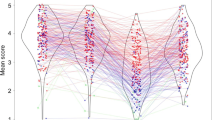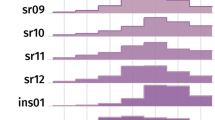Abstract
Methodological confounds and inconsistencies inevaluations of self-statements hamper exploration ofconceptual issues in cognitive assessment. Although manymeasures incorporate both positives and negatives, there is confusion in reporting; rawfrequencies, difference scores, problematic ratios(positive/negative, negative/positive), andStatesof-Mind (SOM) ratios are all used. Here, weexamine methodological issues in evaluations of valencedself-statements in two studies and formulate empiricallybased guidelines for common usage. Our findings clearlyindicate that (a) valenced thought frequencies and SOM ratios yield different information, (b) in SOMratio calculations, inventory scale end points shouldalways start at 0, (c) if scales do not start at 0,scores can be converted mathematically, and (d) the higher the SOM score, the better theindividual's adaptation on various criterion measures;this includes even extremely positive SOMs (0.91 1).Thus, SOMs are monotonic and can be used in statisticalanalyses without transformation.
Similar content being viewed by others
REFERENCES
Alloy, L. B., & Clements, C. M. (1992). Illusion of control: Invulnerability to negative affect and depressive symptoms after laboratory and natural stressors. Journal of Abnormal Psychology, 101,234–245.
Amsel, R., & Fichten, C.S. (1988). Effects of contact on thoughts about interaction with students who have a physical disability. Journal of Rehabilitation, 54(1), 61–65.
Amsel, R., & Fichten, C. S. (1990). Ratio versus frequency scores: Focus of attention and the balance between positive and negative thoughts. Cognitive Therapy and Research, 14, 257–277.
Amsel, R., Wright, J., & Fichten, C. S. (1992, Nov.). Cognitive assessment: Influence of scale values on States of Mind (SOM) ratios. Presentation at the annual convention of the Association for the Advancement of Behavior Therapy, Boston.
Arnkoff, D. B., & Glass, C. R. (1989). Cognitive assessment in social anxiety and social phobia. Clinical Psychology Review, 9, 61–74.
Arnkoff, D. B., Glass, C. R., & Robinson, A. S. (1992). Cognitive processes, anxiety, and performance on doctoral dissertation oral examinations. Journal of Counselling Psychology, 39, 382–388.
Ayres, J. (1988). Coping with speech anxiety: The power of positive thinking. Communication Education, 37, 289–296.
Blankstein, K. R., Flett, G. L., Boase, P., & Toner, B. (1990). Thought listing versus endorsement measures of self-referential thinking in test anxiety. Anxiety Research, 2, 103–111.
Bruch, M. A.. (1997). Positive thoughts or cognitive balance as a moderator of the negative life events-dysphoria relationship: A reexamination. Cognitive Therapy and Research, 21,25–38.
Bruch, M. A., Hamer , R. J., & Kaflowitz-Lindner, N. G. (1992). Cognitive balance and assertiveness: Testing the construct validity of the States of Mind categories. Cognitive Therapy and Research, 16, 653–667.
Bruch, M. A., Heimberg, R. G., & Hope, D. A. (1991). States of Mind model and cognitive change in treated social phobics. Cognitive Therapy and Research, 15, 429–442.
Bruch, M. A., Mattia, J. I., Heimberg, R. G., & Holt, C. S. (1993). Cognitive specificity in social anxiety and depression: Supporting evidence and qualifications due to affective confounding. Cognitive Therapy and Research, 17, 1–21.
Burgess, E., & Haaga, D. A. F. (1994). The Positive Automatic Thought Questionnaire (ATQ-P) and the Automatic Thought Questionnaire-Revised (ATQ-R): Equivalent measure of Positive Thinking? Cognitive Therapy and Research, 18, 15–23.
Cacioppo, J. T., & Berntson, G. G. (1994). Relationship between attitudes and evaluative space: A critical review, with emphasis on the separability of positive and negative substrates. Psychological Bulletin, 115, 401–423.
Chang, E. C., D'Zurilla, T. J., & Maydeu-Olivares, A. (1994). Assessing the dimensionality of optimism and pessimism using a multimeasure approach. Cognitive Therapy and Research, 18, 143–160.
Clark, D. A. (1988). The validity of measures of cognition: A review of the literature. Cognitive Therapy and Research, 12, 1–20.
Clark, L. A., & Watson, D. (1991). Theoretical and empirical issues in differentiating depression from anxiety. In J. Becker & A. Kleinman (Eds.), Psychosocial aspects of depression(pp. 39–65). Hillsdale, NJ: Erlbaum.
Dodge, C. S., Hope , D. A., Heimberg, R. G., & Becker, R. E. (1988). Evaluation of the Social Interaction Self-Statement Test with a social phobic population. Cognitive Therapy and Research, 12, 211–222.
Fichten, C. S. (1986). Self, other and situation-referent automatic thoughts: Interaction between people who have a physical disability and those who do not. Cognitive Therapy and Research, 10, 571–581.
Fichten, C. S., & Amsel, R. (1988). Thoughts concerning interactions between college students who have a physical disability and their nondisabled peers. Rehabilitation Counselling Bulletin, 32, 22–40.
Fichten, C. S., Amsel, R., & Robillard, K. (1988). Issues in cognitive assessment: Task difficulty, reactivity of measurement, thought listing versus inventory approaches, and sequences versus frequency counts. Behavioral Assessment, 10, 399–425.
Fichten, C. S., Amsel, R., Robillard, K., Sabourin, S., & Wright, J. (1997). Personality, attentional focus and novelty effects: Attitudes toward peers with disabilities. Rehabilitation Psychology, 42, 209–230.
Fichten, C. S., Creti, L. Amsel, R., Brender, W., Weinstein, N., & Libman, E. (1995). Poor sleepers who do not complain of insomnia: Myths and realities about psychological and lifestyle characteristics of older good and poor sleepers. Journal of Behavioral Medicine, 18, 189–223.
Fichten, C. S., Lennox, H., Robillard, K., Wright, J., & Amsel, R. (1996). Attentional focus and attitudes toward peers with disabilities: Self focusing and a comparison of modelling and self-disclosure. Journal of Applied Rehabilitation Counselling, 27(4),30–39.
Fichten, C. S., Libman, E., Creti, L., Amsel, R., Tagalakis, V., & Brender, W. (1998). Thoughts during awake times in older good and poor sleepers-The Self-Statement Test: 60+. Cognitive Therapy and Research, 22, 1–20.
Fichten, C. S., Robillard, K., Tagalakis, V., & Amsel, R. (1991). Casual interaction between college students with various disabilities and their nondisabled peers: The internal dialogue. Rehabilitation Psychology, 36, 3–20.
Garamoni, G. L., Reynolds, C. F., III, Thase, M. E., Frank, E., & Fasiczka, A. (1992). Shifts in affective balance during cognitive therapy of major depression. Journal of Consulting and Clinical Psychology, 60, 260–266.
Glass, C. R., & Arnkoff, D. B. (1994). Validity issues in self-statement measures of social phobia and social anxiety. Behaviour Research and Therapy, 32, 255–267.
Glass, C. R., Arnkoff, D. B., Wood, H., Meyerhoff, J. L., Smith, H. R., Oleshansky, M. A., & Hedges, S. M. (1995). Cognition, anxiety, and performance on a career-related oral examination. Journal of Counselling Psychology, 42, 47–54.
Glass, C. R., & Furlong, M. (1990). Cognitive assessment of social anxiety: Affective and behavioral correlates. Cognitive Therapy and Research, 14, 365–384.
Glass, C., Merluzzi, T., Biever, J. & Larsen, K. (1982). Cognitive assessment of social anxiety: Development and validation of a self-statement questionnaire. Cognitive Therapy and Research, 6,37–55.
Haaga, D. A. F., Davison, G. C., McDermut, W., Hillis, S. L., & Twomey, H. B. (1993). “States-of-Mind” analysis of the articulated thoughts of exsmokers. Cognitive Therapy and Research, 17, 427–439.
Heimberg, R. G. (1994). Cognitive assessment strategies and the measurement of outcome of treatment for social phobia. Behaviour Research and Therapy, 32, 269–280.
Heimberg, R. G., Acerra, M. C., & Holstein, A. (1985). Partner similarity mediates interpersonal anxiety. Cognitive Therapy and Research, 9, 443–453.
Heimberg, R. G., Bruch, M. A., Hope, D. A., & Dombeck, M. (1990). Evaluating the States of Mind Model: Comparison to an alternative model and effects of method of cognitive assessment. Cognitive Therapy and Research, 14, 543–558.
Heimberg, R. G., Keller, K. E., & Peca-Baker, T. P. (1986). Cognitive assessment of social evaluative anxiety in the job interview: Job interview self-statement schedule. Journal of Counselling Psychology, 33, 190–195.
Ingram, R. E., Kendall, P. C., Siegle, G., Guarino, J., & McLaughlin, S. C. (1995). Psychometric properties of the Positive Automatic Thoughts Questionnaire. Psychological Assessment, 7, 495–507.
Ingram, R. E., Slater, M. A., Atkinson, J. H., & Scott, W. (1990). Positive automatic cognition in major affective disorder. Psychological Assessment, 2, 209–211.
Jolly, J. B., & Dykman, R. A. (1994). Using self-report data to differentiate anxious and depressive symptoms in adolescents: Cognitive content specificity and global distress. Cognitive Therapy and Research, 18, 25–37.
Kendall, P. C. (1984). Behavioral assessment and methodology. In C. M. Franks, G. T. Wilson, P. C. Kendall, & K. D. Brownell (Eds.), Annual review of behavior therapy: Theory and practice(Vol. 10, pp. 47–86). New York: Guilford.
Kendall, P. C., Howard, B. L., & Hays, R. C. (1989). Self-referent speech and psychopathology: The balance of positive and negative thinking. Cognitive Therapy and Research, 13, 583–598.
Libman, E., Creti, L., Amsel, R., Brender, W., & Fichten, C. S. (1997a). What do older good and poor sleepers do during periods of nocturnal wakefulness? The Sleep Behaviors Scale: 60+. Psychology and Aging, 12, 170–182.
Libman, E., Creti, L., Levy, R. D., Brender, W., & Fichten, C. S. (1997b). A comparison of reported and recorded sleep in older poor sleepers. Journal of Clinical Geropsychology, 3, 199–211.
Markman, H. J. (1991). Constructive marital conflict is not an oxymoron. Behavioral Assessment, 13, 83–96.
Marshall, G. N., Wortman, C. B., Kusulas, J. W., Hervig, L. K., & Vickers, R. R. Jr.. (1992). Distinguishing optimism from pessimism: Relations to fundamental dimensions of mood and personality. Journal of Personality and Social Psychology, 62, 1067–1074.
McDermut, W., & Haaga, D. A. F. (1994). Cognitive balance and specificity in anxiety and depression. Cognitive Therapy and Research, 18, 333–354.
Merluzzi, T.V. (1993). Cognitive assessment: Clinical applications of self-statement assessment. Journal of Counselling & Development, 71, 539–545.
Myszka, M. T., Galassi, J. P., & Ware, W. (1986). Comparison of cognitive assessment methods with heterosocially anxious college women. Journal of Counselling Psychology, 33, 401–407.
Nash, J. D. (1993). Self-talk of dieters and maintainers: States of mind, stimulus situation, binge eating, weight cycling, and severity of weight problem. Dissertation Abstracts International, 54(4), 2216-B.
Scheier, M. F., & Carver, C. S. (1992). Effects of optimism on psychological and physical well-being: Theoretical overview and empirical update. Cognitive Therapy and Research, 16, 201–228.
Schwartz, R. M. (1986). The internal dialogue: On the asymmetry between positive and negative coping thoughts. Cognitive Therapy and Research, 10, 591–605.
Schwartz, R. M. (1992). States of Mind model and personal construct theory: Implications for psychopathology. International Journal of Personal Construct Psychology, 5(2), 123–143.
Schwartz, R. M., & Garamoni, G. L. (1986). A structural model of positive and negative states of mind: Asymmetry in the internal dialogue. In P. C. Kendall (Ed.), Advances in cognitive-behavioral research and therapy. (Vol. 5, pp. 1–62). New York: Academic Press.
Schwartz, R. M., & Garamoni, G. L. (1989). Cognitive balance and psychopathology: Evaluation of an information processing model of positive and negative states of mind. Clinical Psychology Review, 9, 271–294.
Schwartz, R. M., & Michelson, L. (1987). States-of-mind model: Cognitive balance in the treatment of agoraphobia. Journal of Consulting and Clinical Psychology, 55, 557–565.
Schwartz, R. M. (1997). Consider the simple screw: Cognitive science, quality improvement, and psychotherapy. Journal of Consulting and Clinical Psychology, 65, 970–983.
Taylor, S. E. & Brown, J. D. (1988). Illusion and well-being: A social psychological perspective on mental health. Psychological Bulletin, 103, 193–210.
Vollhardt, L. T. (1991). Psychoneuroimmunology: A literature review. American Journal of Orthopsychiatry, 61, 35–47.
Watson, D., Clark, L. A., McIntyre, C. W., & Hamaker, S. (1992). Affect, personality, and social activity. Journal of Personality and Social Psychology, 63, 1011–1025.
Rights and permissions
About this article
Cite this article
Amsel, R., Fichten, C.S. Recommendations for Self-Statement Inventories: Use of Valence, End Points, Frequency, and Relative Frequency. Cognitive Therapy and Research 22, 255–277 (1998). https://doi.org/10.1023/A:1018744826190
Issue Date:
DOI: https://doi.org/10.1023/A:1018744826190




